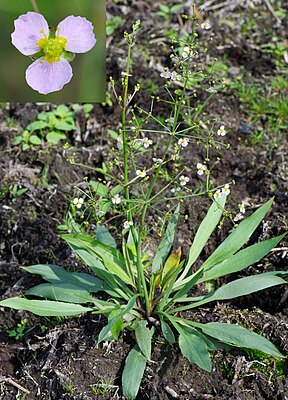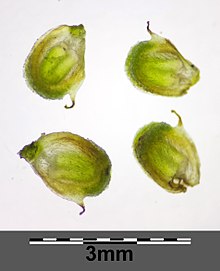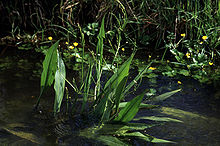Lancet-leaved frog spoon
| Lancet-leaved frog spoon | ||||||||||||
|---|---|---|---|---|---|---|---|---|---|---|---|---|

Lancet-leaved frog spoon ( Alisma lanceolatum ) |
||||||||||||
| Systematics | ||||||||||||
|
||||||||||||
| Scientific name | ||||||||||||
| Alisma lanceolatum | ||||||||||||
| With. |
The Lanzettblättrige water plantain ( Alisma lanceolatum ), also lancet water plantain called, is a plant from the family of alismataceae (Alismataceae). This marsh plant is mainly found in Eurasia . It occurs far less frequently than the common frog spoon ( Alisma plantago-aquatica ), but it cannot be clearly distinguished from it in every case. In addition, the two species can form intermediate-looking hybrids .
description
Vegetative characteristics
The lancet-leaved frog spoon grows in damp locations as a deciduous, perennial , herbaceous plant and reaches heights of growth of around 20 to 50 (70) centimeters when the rather high, leafless inflorescence is fully developed in summer. Sprout tubers with a diameter of 1 to 2 centimeters are formed as persistence organs . All parts of the plant are bare.
Foliage leaves are formed both under (submersed) and above (emersed) the surface of the water . The non-submerged leaves are divided into petiole and leaf blade. The petiole has a length of 13 to 25 centimeters. With a length of 6 to 13 centimeters and a width of 1.5 to 5 centimeters (sometimes also slightly larger), more or less broadly lanceolate or elliptical leaf blades have five to seven leaf veins and typically appear a bit blue-green. The leaf base gradually narrows into the stem. As with most frog-spoon plants, the underwater leaves that are initially produced are rather ribbon-shaped.
Generative characteristics
Compared to the common frog spoon , the inflorescence is somewhat more compact and less expansive. The total inflorescence is up to 70 centimeters long and has three to six branches with a total of 15 to 45 paniculate partial inflorescences. The triangular-egg-shaped bracts have a length of 5 to 10 millimeters. The flower stalks have a length of 1.5 to 2.5 centimeters.
The relatively small flowers are hermaphroditic and threefold with a double flower envelope . The three green, broadly egg-shaped sepals have a length of 1.5 to 3.2 millimeters and a width of 2 to 2.5 millimeters. The three pale pink to pale purple colored petals are 4 to 6.5 millimeters in length larger than the sepals, almost circular and often pointed in the middle.
The six stamens are in a circle. The stamens are about 2 millimeters long. The elliptical or elongated anthers have a length of 0.6 to 1.2 millimeters. The ovary has a length of 0.4 to 0.6 millimeters. The more or less upright stylus , which has the function of a scar in the upper third (up to half) , reaches a length of 0.6 to 1 millimeter. A clear distinction between the two species is possible on the basis of the flower morphology: the stigmatous area in Alisma lanceolatum is 0.3 to 0.8 millimeters on average only half as large and covered with coarse papillae ( Alisma plantago-aquatica only has small papillae in the foremost fifth of the stylus).
The flowers open in the morning and are usually closed again in the afternoon, whereas the common frog spoon usually opens its white to pale pink flowers around noon and keeps them open in the afternoon. The flowering period extends from May to September, in Central Europe this is in midsummer.
The obovate, light brown achenes have a length of 1.6 to 2 (rarely up to 3) millimeters, one to two grooves and an upright beak. The fruits ripen from June to September. The reddish-brown seeds are oblong with a length of about 1.5 millimeters.
The number of chromosomes is 2n = 26, 28, 34 or 36.
Occurrence
The natural range of Alisma lanceolatum stretches from Europe to Central Asia and China, and the species is also distributed in northwest India as well as in northwest African Maghreb and Macaronesia. It has also been introduced to South America, southern Australia, and the United States and spreads through seeds and their tubers. For the USA, the states of Oregon and California in the west are particularly known for their occurrences. Alisma lanceolatum is rated as a dangerous invasive plant in wetlands, especially in wet rice cultivation .
Within Europe, the area extends northwards to Scotland and southern Scandinavia. The main areas of occurrence in Central Europe are the larger river valleys; in between there are sometimes extensive gaps in distribution. In some federal states of Germany the species is listed on Red Lists of Endangered Species (but not nationwide), regionally it is sometimes even considered "critically endangered". In Austria, too, the species is scattered to rare and classified as "endangered". The distribution in Switzerland is very unsteady and limited to lower altitudes. The national risk assessment is: "vulnerable" (endangered / vulnerable).
Alisma lanceolatum populated shores and summery dry falling mud, sand, clay and silt soil nutrients and base-rich sites, such as Auentümpeln, ditches or field kettle holes . It also grows locally at electrolyte- rich inland salt sites , but not on the North Sea coast. According to the Ellenberg pointer values , it is, among other things, a heat (T7) and a weak base pointer (R7), but above all an alternating water pointer (F10). From a plant-sociological point of view, the amphibious sites are predominantly assigned to the reed beds and large sedge beds (order Phragmitetalia australis). Like other frog spoon species, Alisma lanceolatum is used as an ornamental plant on garden ponds.
Systematics
Alisma lanceolatum was 1796 William Withering in An Arrangement of British Plants , Third Edition, 2, p 362 first published . Synonyms are Alisma plantago-aquatica var. Lanceolatum (With.) Lej. and Alisma stenophyllum Samuelsson.
swell
literature
- Robert R. Haynes & C. Barre Hellquist: Alismataceae in the Flora of North America , Volume 22, 2000: Alisma lanceolatum - Online.
- Qingfeng Wang, Robert R. Haynes & C. Barre Hellquist: Alismataceae in der Flora of China , Volume 23, 2010, p. 88: Alisma lanceolatum - Online.
- Abdul Ghafoor: Alismataceae in the Flora of Pakistan : Alisma lanceolatum - Online.
- Henning Haeupler , Thomas Muer: picture atlas of the fern and flowering plants of Germany (= the fern and flowering plants of Germany. Volume 2). Published by the Federal Agency for Nature Conservation. Ulmer, Stuttgart 2000, ISBN 3-8001-3364-4 .
- Heinz-Dieter Krausch : Color atlas of water and bank plants. Ulmer, Stuttgart 1996; P. 218. ISBN 3-8001-3352-0
- Erich Oberdorfer : Plant-sociological excursion flora . Ulmer, Stuttgart, 6th edition 1990. ISBN 3-8001-3454-3
- Richard Pott: The plant communities in Germany. Ulmer, Stuttgart 1992. ISBN 3-8252-8067-5
Individual evidence
- ^ Erich Oberdorfer : Plant-sociological excursion flora for Germany and neighboring areas . With the collaboration of Angelika Schwabe and Theo Müller. 8th, heavily revised and expanded edition. Eugen Ulmer, Stuttgart (Hohenheim) 2001, ISBN 3-8001-3131-5 , pp. 110 .
- ↑ Rafaël Govaerts (Ed.): Alisma lanceolatum - data sheet at World Checklist of Selected Plant Families of the Board of Trustees of the Royal Botanic Gardens, Kew. Last accessed on August 19, 2016.
- ↑ a b c (Australian) National Weeds Strategy . ( Memento of the original from July 26, 2008 in the Internet Archive ) Info: The archive link was automatically inserted and not yet checked. Please check the original and archive link according to the instructions and then remove this notice.
- ↑ Natural Resources Conservation Service (USA): Plants Database
- ↑ FloraWeb: Alisma lanceolatum - endangerment and protection
- ↑ Botanik im Bild / Flora von Österreich: Alisma lanceolatum
- ↑ Web Swiss Flora (click on "Alisma lanceolatum")
- ↑ Eckhard Garve: Atlas of the endangered fern and flowering plants in Lower Saxony and Bremen. Part 1: A - K. Nature conservation and landscape management in Lower Saxony 30/1 (1994): p. 79. ISBN 3-922321-68-2
- ↑ FloraWeb: Alisma lanceolatum - Habitat and Ecology
- ^ Alisma lanceolatum at Tropicos.org. Missouri Botanical Garden, St. Louis
Web links
- Lancet-leaved frog spoon. In: FloraWeb.de.
- Lancet-leaved frog spoon . In: BiolFlor, the database of biological-ecological characteristics of the flora of Germany.
- Profile and distribution map for Bavaria . In: Botanical Information Hub of Bavaria .
- Alisma lanceolatum With., Map for distribution in Switzerland In: Info Flora , the national data and information center for Swiss flora .
- Distribution in the Netherlands [1] (Dutch)
- Distribution map for Alisma lanceolatum in the northern hemisphere
- Thomas Meyer: Data sheet with identification key and photos at Flora-de: Flora von Deutschland (old name of the website: Flowers in Swabia )


